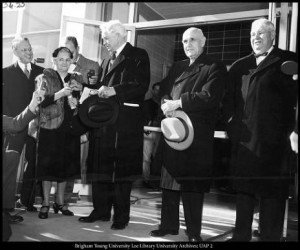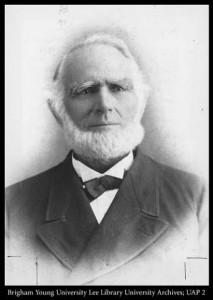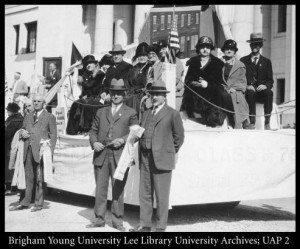J. Reuben Clark Building:

Named after Joshua Reuben Clark, Jr. (Sept. 1, 1871 – Oct. 6, 1961), who was an American attorney, civil servant and a prominent leader in The Church of Jesus Christ of Latter-day Saints.
J. Reuben Clark held many prominent positions in the US government, including Assistant Solicitor and Solicitor of the U.S. State Department. He later became the Undersecretary of State for U.S. President Calvin Coolidge, as well as U.S. Ambassador to Mexico from 1930-1933. While serving in other government positions, President J. Reuben Clark was also counselor to three Church Presidents, including Heber J. Grant, George Albert Smith, and David O. Mckay. During his Church service, he initiated the program that broadcast General Conference to additional assembly halls via closed-circuit radio. He was also a guiding figure of the Church’s Welfare Program.
Dedicated: 1975
This building currently holds the J. Reuben Clark Law School, as well as the Dallin H. Oaks Law Library.
Harvey Fletcher Building:

Named after Harvey Fletcher (Sept. 11, 1884 – July 23, 1981), who was an American physicist. Known as the “father of stereophonic sound,” he is credited with the invention of the audiometer and hearing aid. He is remembered as a trail-blazing investigator into the nature of speech and hearing, and for his numerous contributions in acoustics, electrical engineering, speech, medicine, music, atomic physics, sound pictures and education. He was also the first dean of the School of Engineering.
Dedicated 1953
The Fletcher Building was constructed in an “H” shape in 1953, containing a wing for each of the four engineering departments. In 1953, a second floor was added in three of the four wings and in 1964, the fourth wing was remodeled. The Harvey Fletcher Building still houses labs for Mechanical and Chemical Engineering, but it is primarily used by the Office of Information Technology as work and office space.

Abraham Smoot Building:
Named after Abraham Owen Smoot (Feb. 17, 1815–March 22, 1895), who was an early president (1875-1895) of the Brigham Young Academy Board of Trustees. Abraham O. Smoot gave so unselfishly of himself and his finances that at his death, it was learned he was bankrupt, having used his personal fortune to keep BYU’s doors open.
Dedicated 1961
The Smoot Building, also called the ASB, is shaped like an X and houses most of the university’s administrative offices.
John A. Widtsoe Building
Named after John Andreas Widtsoe (Jan. 31, 1872 – Nov. 29, 1952), who was a BYU professor and a leading scientist in agriculture and soil chemistry. He was also an apostle for the LDS Church and a member of the BYU Board of Trustees.
Dedicated: 1968

The nine-story building is the home of the College of Biology and Agriculture, and each floor houses a specific area of study, complete with offices, laboratories and classrooms. Basement hallways are lined with 15 live aquariums to enhance the study of marine biology.
The Widtsoe Building will be replaced by the new Life Sciences Building, which is currently under construction. Upon completion of the new building, the Widtsoe Building will be demolished.




